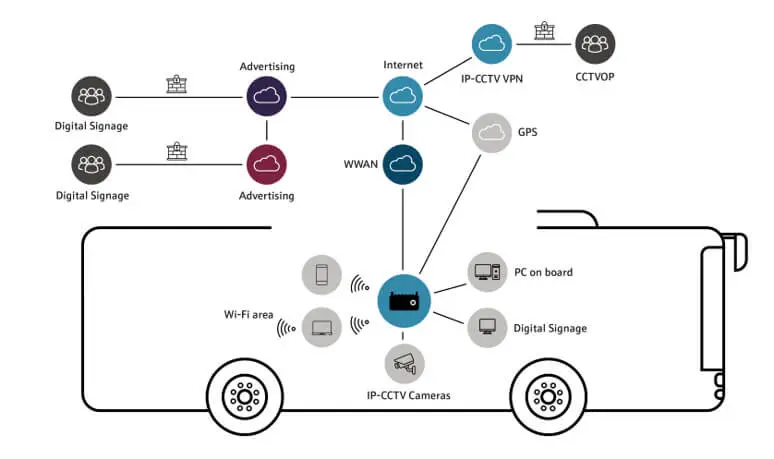Total Connectivity for Buses
Increase passenger comfort and security, with Wi-Fi, onboard video and alarm system.
Teldat H2-Automotive+: In-vehicle rugged router for Madrid buses
The H2-Automotive+ is a multiservice communications platform for Teldat vehicles. It provides 4G LTE broadband and Wi-Fi communications, together with redundancy and aggregation options, advanced network security mechanisms, and an extended operating temperature range.

Client Summary
The Madrid Public Transport Company (EMT) is a leading public transport operator. It has 2,100 buses traveling on 209 routes covering a total distance of 3,690 km. Annually, EMT buses cover more than 90 million kilometres and 425 million passengers use the service, making it one of the largest bus operators in the world. The buses are the only public transport system in Madrid to operate 24 hours a day. The network as a whole is undergoing a process of continual improvement to optimize speed, quality and sustainability. EMT’s main objective is to offer high-quality, effective and efficient transport.
Summary
Challenge
- Passengers will feel more secure and have greater peace of mind knowing that buses are equipped with a video surveillance system.
- The device lets EMT control all of its bus routes, including the passenger Wi-Fi.
- A large number of mobile devices can be managed through a converged communications infrastructure.
- Scaling up of services by adding: dynamic marketing and ticketing services, among others.
Solution
- Teldat’s H2-Automotive+ routers, with ruggedized chassis, industrial-grade electronic components, etc., meet all expectations and certifications.
- The H2-Automotive+ router’s integrated switch assembles in-vehicle applications for drivers in a single reception center.
- VPN features ensure a permanent, secure mobile connection to the EMT corporate network.
- Multi-purpose Wi-Fi provides Internet access through high-quality connection technologies.
Results
- Teldat has extensive experience in providing WAN access solutions and working with carriers to obtain management services.
- The H2-Automative+ router’s wireless services and ruggedness were exactly what this project required.
- The Wi-Fi interface allows passengers to connect to the Internet through their cell phones.
- Quality of service (QoS) and security technologies prevent passengers from accessing corporative services.

Why Teldat?
The customer chose Teldat in 2010 and again in 2017 for a number of reasons:
- As a manufacturer, Teldat has extensive experience when it comes to providing corporate WAN access equipment and working with carriers to obtain the necessary management services. In addition, the client was impressed by the quality of service provided in the first phase, so it decided to use the same manufacturer to renew the routers.
- The Teldat devices were the perfect solution for a demanding project like this because of their wireless services and ruggedness (anti-shock and anti-vibration protection and high temperature dissipation).
- The Wi-Fi interface/corporate network software package combination.
- The possibility of passengers being able to access the Internet through the mobile connection when the bus in moving.
- The use of QoS and security technologies to prevent passengers from accessing corporate services.

Challenge
This project is composed of two separate phases. Phase one, in 2010, consisted of installing 2,200 Teldat H1-Automotive devices on EMT buses. Phase two, a renewal phase implemented in 2017, involved the routers being replaced by their latest version, the Teldat H2-Automotive+.
Initially, the main objective was to make the bus network safer and more comfortable by installing a series of CCTV cameras (operated and managed from an Alarm Reception Center) throughout the bus fleet. To ensure a high resolution and real-time access to on-board camera footage from the Alarm Reception center, the buses required a reliable broadband connection.
The existing radio link network was providing insufficient bandwidth so EMT opted to take out a mobile broadband contract with the operator. EMT also wanted a device that would allow voice over IP calls and at the same time act as an on-demand GSM Gateway. This allows passengers to make GSM calls when there is insufficient quality for VoIP calls.
In 2017, EMT decided to switch to the latest model with a view to increasing services. The client wanted to be able to add features, such as dynamic marketing and ticketing systems, while continuing to both provide connectivity to passengers and maintain the CCTV cameras. In short, EMT’s top priority was to be prepared for the future, which required a device that could grow to cope with the necessary expansion of services, and, at the same time, maintain the quality provided so far.
Solution
Teldat installed H1-Automotive routers in the first project in 2010, and H2-Automotive+ routers in the 2017 project. Both devices are housed in a ruggedized chassis and feature a wide range of industrial-grade electronic components, versatile installation options, and certification against voltage peaks in the power supply.
Regarding security, each bus is fitted with two cameras (four for articulated buses) with DVR recording devices that generate alarms and stream live footage back to a reception center. Operators at the center have real-time access to the video feeds from the bus cameras. Thanks to a (4-port) switch installed on the H2-Automotive+, said center can also monitor various applications linked to the platform. VPN features ensure a secure, reliable connection to EMT’s corporate network. Teldat’s H2-Automotive+ offers 4G, Wi-Fi and Ethernet connections locally over the LAN and a wireless access solution through the WAN integrated in EMT’s corporate network (managed by the operator).
The use of standard management technologies allows the routers to be incorporated into EMT’s Communications Management Platform. The on-board LAN network acts as an extension to the corporate network thanks to tunnel protocols, security policies and other mechanisms that prevent possible attacks by passengers. Active WWAN monitoring mechanisms optimize communications for on-board applications.
The multi-purpose Wi-Fi provides on-board connectivity by employing value-added network technologies such as per-user bandwidth limitation and QoS (which guarantees that the aforementioned services work at full capacity). Furthermore, the Teldat H2-Automative+ router installed in EMT has two LTE modules. This means you can use SIMs from two different operators and thereby achieve communication redundancy.

Results
In both phases, the devices were gradually installed throughout EMT’s Madrid bus fleet. The following results can be highlighted:
- Increase in the number of passengers using EMT buses and a fall in car use.
Passenger “peace of mind”/comfort skyrocketed to 96.1%. - Driver satisfaction improved due to increased workplace security.
- EMT played a fundamental role in promoting this project.
Public transport operators around the world have paid close attention to the project and have decided to implement the solution in major metropolitan areas (or adopt a similar solution in the future).
Download Case Study PDF
Explore more Case Studies
A selection of case studies demonstrating how Teldat helps clients around the world, across industries, solve their toughest issues and build long-term value.
Connecting public Bycicle Service in the city of Taipei
Convenient & safer bus travel
Safe buses connectivity to police cars
Transforming ambulances into mobile emergency services


























